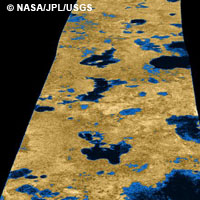Lost seas of Titan found
Scientists say they have uncovered evidence of lakes of liquid methane on Saturn's largest moon, Titan. The radar imaging system of the Cassini-Huygens probe pierced through the dense smoggy atmosphere of the moon to reveal 75 dark patches in the range of 3 to 70km across in the moon's northern hemisphere. The Cassini-Huygens mission is a cooperative project between the US space agency (NASA), the European Space Agency (ESA) and the Italian Space Agency (ASI). According to the team, which published its findings in the journal Nature, everything about these patches points to them being pools of liquid. 'They look very similar to lakes on Earth,' explained Dr Ellen Stofan, a Cassini radar team member. 'They have channels feeding into them just like you have rivers feeding into lakes on the Earth. Their shapes, their shore-lines, all of those geologic aspects are actually very familiar.' With the atmosphere on Titan composed mostly of nitrogen and carbon-based compounds, and with temperatures hovering around -179°celsius, scientists believe the liquid in the lakes is methane, with some ethane mixed in. They expect some of the liquid fell as rain from the sky, whilst some could have come from below the surface. 'The methane-ethane would become transparent, the way water is on Earth; it would be behaving like water, the lakes could have small waves on the surfaces,' speculated Dr Stofan. Titan could then be the only other place in the Solar System to have a similar, active fluid cycle to the Earth's hydrological cycle. Scientists have already dubbed it the 'methane-ologic cycle'.



